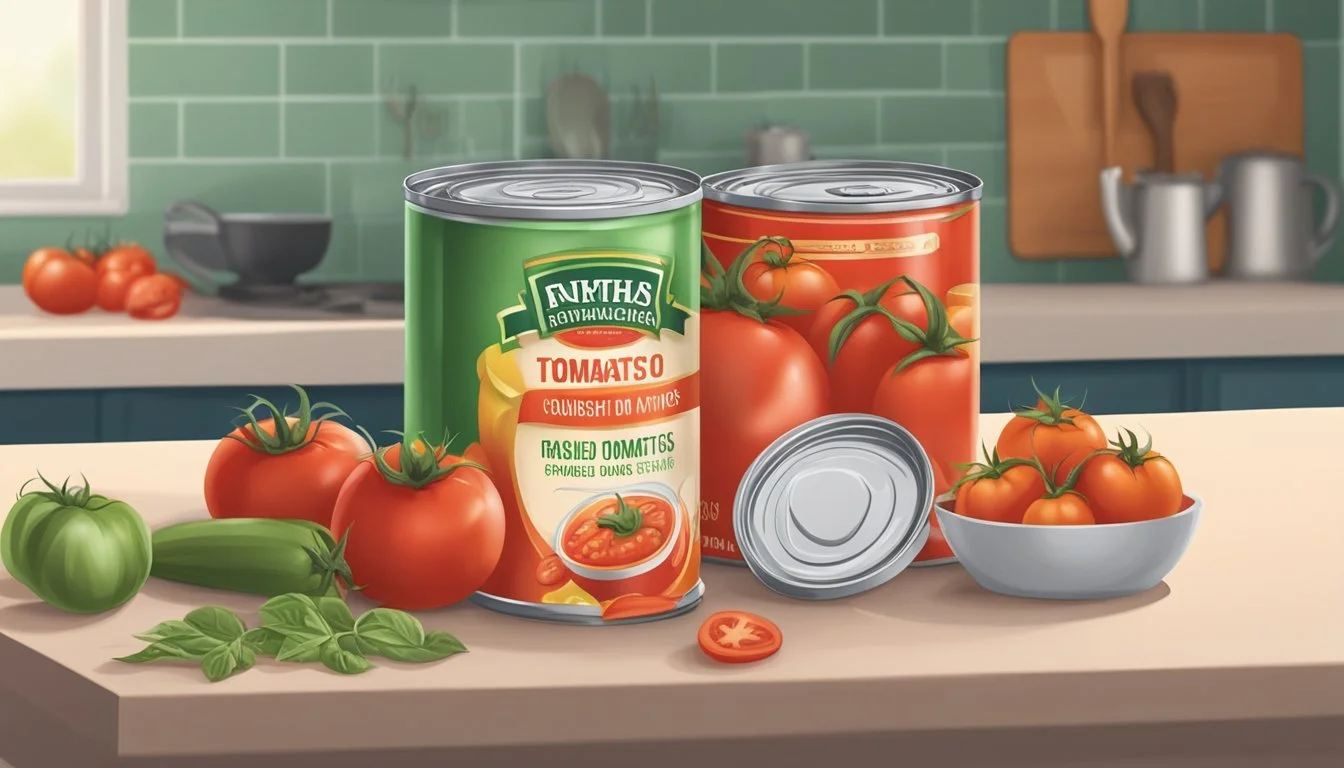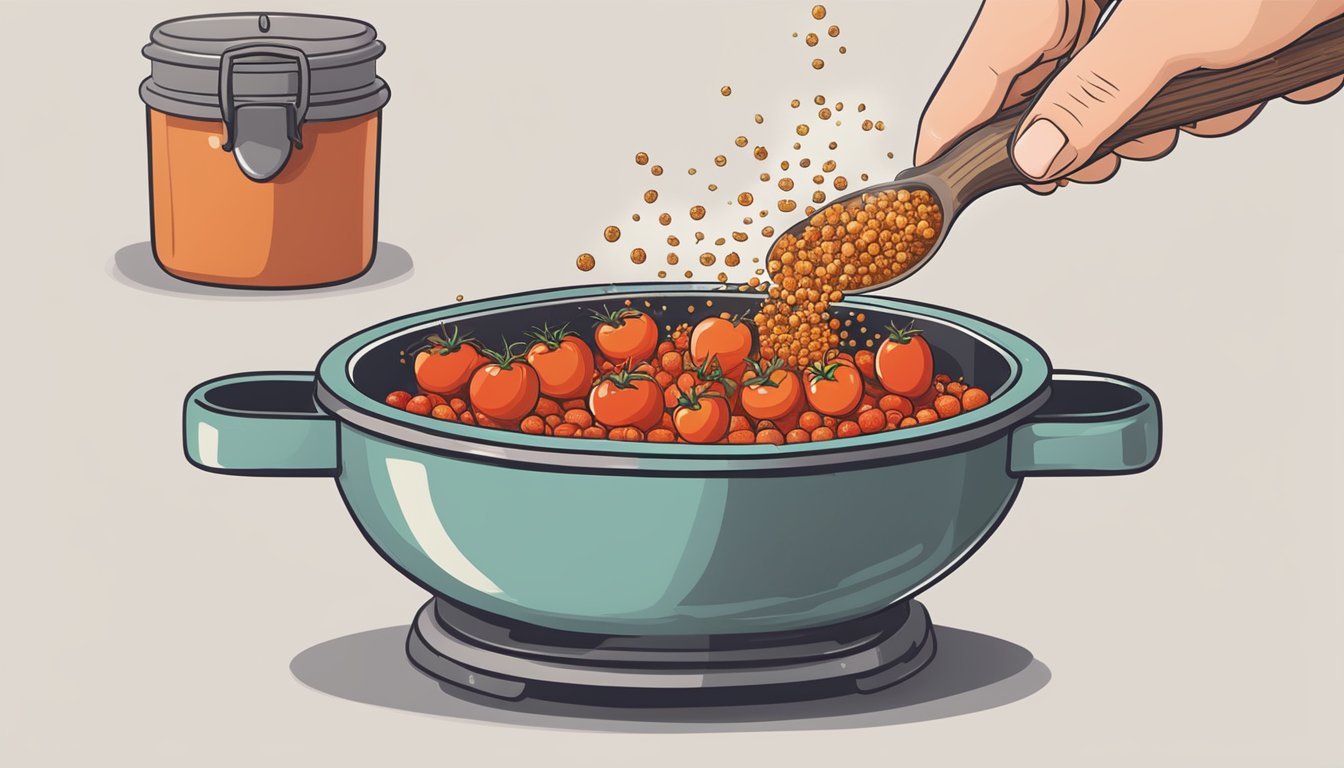Crushed Tomatoes Substitutes
Best Alternatives for Cooking
When you find yourself in the middle of cooking and realize you're out of crushed tomatoes, don't panic. There are several substitutes that can seamlessly step in and save your recipe. One of the most versatile alternatives is tomato paste, which, although thicker, can be thinned down with water to mimic the texture of crushed tomatoes.
Another reliable option is jarred pasta sauce. This substitute works well in a one-to-one ratio with crushed tomatoes, making it a convenient choice for many recipes. For those looking to add a bit more flavor, fresh tomatoes can be peeled, cored, and mashed to recreate the consistency and taste of crushed tomatoes effectively.
For those who prefer a slightly different texture, diced tomatoes can also be used after a quick blend. This provides a chunkier consistency but still maintains the rich tomato flavor essential to many dishes.
Understanding Crushed Tomatoes
Crushed tomatoes are a versatile tomato product commonly used in various dishes. This section covers their basic attributes, culinary uses, and a comparison with other tomato products.
The Basics of Crushed Tomatoes
Crushed tomatoes are made from ripe tomatoes that have been skinned, cored, and mashed to a fine consistency. They often include a blend of tomato puree and sometimes a small amount of tomato paste for added thickness. This process creates a smooth texture, somewhere between tomato sauce and diced tomatoes. Crushed tomatoes are available in canned form and are a pantry staple. They offer convenience and a fresh, robust flavor.
Culinary Uses of Crushed Tomatoes
Crushed tomatoes are fundamental in cooking a variety of dishes. They are a key ingredient in tomato-based sauces such as marinara and pasta sauce. The smooth texture integrates well in stews and soups, adding both flavor and consistency. Their thick quality makes them perfect for slow-cooked dishes, allowing them to meld with other ingredients. Adding herbs, garlic, or spices can further enhance their richness and depth. Crushed tomatoes are also used in curries, casseroles, and chili.
Comparing Crushed Tomatoes and Other Tomato Products
Crushed tomatoes stand out among other tomato products due to their unique texture and versatility. While tomato sauce is completely smooth, crushed tomatoes have a slightly chunkier consistency. Diced tomatoes consist of small, firm pieces and lack the smoothness of crushed tomatoes.
Here’s a comparison:
Tomato Product Texture Common Uses Crushed Tomatoes Smooth, slightly chunky Sauces, stews, soups Tomato Sauce Completely smooth Pasta sauce, pizza sauce Diced Tomatoes Firm, chunky pieces Salads, chunky soups Whole Tomatoes Intact, peeled Soups, stews, sauces Tomato Puree Thick, smooth Sauces, base for other dishes Tomato Paste Very thick, concentrated Flavoring, thickening
Crushed tomatoes are especially good for recipes requiring a thick, yet slightly textured tomato base, making them indispensable in many kitchens.
Fresh Alternatives to Crushed Tomatoes
Fresh alternatives to crushed tomatoes can be simple and rewarding. Using fresh tomatoes like Roma can give you control over the flavor and texture of your dishes.
Preparing Fresh Tomatoes
To start, select fresh Roma tomatoes from the grocery store. Roma tomatoes are ideal due to their low moisture content and rich flavor.
Peeling the tomatoes is crucial for a smoother texture. Boil water and submerge the tomatoes for 30-60 seconds until the skins split. Transfer them to an ice bath to cool, then peel off the skins easily.
Next, seed the tomatoes to avoid excess liquid. Cut them in half and remove the seeds with a spoon to leave only the flesh.
Finally, quarter the tomatoes for more manageable pieces before crushing or processing them.
Homemade Crushed Tomato Techniques
There are several methods to make homemade crushed tomatoes. Start by placing the peeled and seeded tomatoes in a large pot. Use a masher to break them down.
Alternatively, use a blender or food processor for a finer consistency. Pulse lightly to avoid turning the tomatoes into a puree.
Tomato paste or puree can be added to achieve the desired thick texture and richer flavor. These additions also help replicate the consistency of canned crushed tomatoes.
Incorporate spices and herbs like basil or oregano while simmering the mixture for a customized taste. This method not only matches the convenience of canned options but also enhances the flavor with fresh ingredients.
Canned Tomato Substitutes
Various canned tomato options can effectively replace crushed tomatoes, each offering unique benefits regarding texture, consistency, and flavor.
Utilizing Diced Tomatoes
Diced tomatoes can serve as a good substitute for crushed tomatoes. Their chunkier texture may differ, but this can be adjusted. Pulse diced tomatoes in a blender or food processor briefly to reach a more crushed consistency.
Adding tomato paste can help thicken the mixture. Consider blending with seasonings like fresh basil or oregano to enhance flavor. This method works well for pasta sauces and other thick preparations where consistency aligns closely with crushed tomatoes.
Whole Canned Tomatoes as a Substitute
Whole canned tomatoes are versatile and can replicate crushed tomatoes effectively. To use these, transfer to a blender or mash them by hand for desired texture.
They usually pack more flavor, especially San Marzano varieties, renowned for their rich taste. When blending whole canned tomatoes, it’s easier to control the thickness. They’re particularly useful in dishes that require a smooth, robust tomato base such as stewed tomatoes and curries.
Tomato Paste and Sauce for Thickening
Combining tomato paste and tomato sauce can mimic the consistency of crushed tomatoes. Mix equal parts, or adjust to preference, ensuring the mixture doesn’t become too watery.
Tomato paste adds depth and density, while tomato sauce contributes volume. This combination is apt for recipes demanding a thick texture, like casseroles or lasagna. Additionally, both elements can be flavored to match taste requirements.
Specialty Tomato Alternatives
Specialty tomatoes such as fire-roasted tomatoes or sun-dried tomatoes can also serve as unique substitutes. Fire-roasted tomatoes offer a slight smokiness, enhancing dishes with a deeper flavor profile.
Sun-dried tomatoes, often packed in oil, boast concentrated flavors and can be blended into a paste. These alternatives might be more suitable for gourmet dishes or where a more intense, seasoned tomato presence is desired.
Using diverse types of tomatoes, including passata, gives more flexibility and can tailor recipes to specific culinary needs.
Non-Tomato Based Substitutes
For those looking to replace crushed tomatoes with non-tomato alternatives, there are several vegetable-based and sauce-based options that can provide similar textures and flavors.
Using Other Vegetables
Pumpkin Puree: For a creamy and slightly sweet alternative, pumpkin puree works well in soups and stews. Its smooth texture mimics that of crushed tomatoes, though it may slightly alter the flavor profile of the dish.
Roasted Red Peppers: These can be blended into a puree to offer a smoky and sweet taste. When used, they provide a vibrant color and rich flavor, suitable for dishes like pasta sauces and casseroles.
Carrots and Sweet Potatoes: Both vegetables, when cooked and mashed, can replace crushed tomatoes. They add a hint of sweetness and a thick consistency. Consider pureeing them and mixing with a bit of vegetable broth to achieve the desired texture.
Alternative Sauces and Condiments
Marinara Sauce: A readily available substitute, marinara sauce can be used directly to replace crushed tomatoes. It offers similar consistency and a rich flavor profile, making it ideal for pasta dishes.
Salsa: For a chunkier texture, salsa can be used. It incorporates various vegetables and spices, providing a zesty flavor. This substitute works well in Mexican-inspired dishes and dips.
Ketchup and Condensed Tomato Soup: Ketchup adds a sweet-tart flavor but should be used sparingly due to its high sugar content. Condensed tomato soup provides a smooth texture and can be diluted with water or broth to mimic crushed tomatoes. Both are best suited for recipes where a slight alteration in flavor is acceptable.
Flavor and Seasoning Adjustments
Adjusting the flavor and seasonings when substituting for crushed tomatoes can enhance the final dish.
Spices such as ground cumin, paprika, and chili powder can add depth and warmth. When adding these spices, start with small amounts and adjust to taste.
Incorporate herbs like fresh or dried basil, oregano, or thyme. These herbs provide a fragrant and earthy aroma that complements tomato-based dishes.
Using salt is crucial. It enhances the natural tomato flavor and balances the dish. Start with a pinch and add more as needed.
Address the acidity by adding a small amount of sugar or baking soda. This will help neutralize excessive tartness, creating a more balanced flavor.
Garlic, whether minced or in powder form, can inject a robust flavor. Adding one or two cloves of minced garlic to the substitute can significantly lift the taste profile.
Incorporating olive oil can enrich the dish. A tablespoon or two can provide a silky texture and a subtle, fruity taste.
Enhance the tomato flavor with tomato paste. Its concentrated nature intensifies the overall taste while improving the consistency of the substitute.
Carefully balancing these elements will create a substitute that closely mimics the rich flavor and seasoning profile of crushed tomatoes.
Substitutes for Specific Dishes
Finding the right substitute for crushed tomatoes can significantly affect the outcome of a dish. Different recipes require unique textures and flavors, making the choice of substitute important.
Best Substitutes for Pasta and Pizza
For pasta and pizza, crushed tomatoes provide a balanced combination of texture and flavor. Tomato puree mixed with tomato paste can replicate this. They give the sauce a smooth consistency while maintaining a rich flavor.
For marinara sauce or pizza sauce, using diced tomatoes pulsed in a blender until they have a pulpy texture can work well. To enhance flavor, add a tablespoon of tomato paste.
Ingredient Use Case Tomato Puree Pasta sauces, pizza sauces Tomato Paste Enhances flavor and thickens the sauce Diced Tomatoes Blended to mimic the consistency of crushed
Choosing Substitutes for Soups and Stews
Crushed tomatoes add both body and flavor to soups and stews. A good substitute here is whole canned tomatoes. Process them lightly in a blender to achieve the desired consistency.
Tomato sauce combined with a bit of tomato paste can also be used for a smoother texture. This combination works well in tomato soup, chili, and other hearty dishes, offering the right balance of thickness and taste.
Substitutes in Casseroles and Bakes
For casseroles and bakes, such as lasagna or oven-baked ravioli, a mixture of tomato sauce and tomato paste can replace crushed tomatoes. This provides a thick and rich sauce suitable for layering and baking.
Stewed tomatoes can be another option, offering a chunky texture. They add depth and complexity to the dish, bringing a hearty, home-cooked feel. Make sure to adjust cooking time if you are substituting based on the thickness of the chosen ingredient.
Alternative Ingredients in Ethnic Cuisine
When preparing ethnic dishes like curries and masala, you can use fresh tomatoes blended with a little water and spices. This combination will help mimic the authentic flavors and texture.
Canned diced tomatoes blended with some tomato paste are particularly effective in dishes like spicy curries. They provide the necessary thickness and depth of flavor. For dishes requiring a more concentrated flavor, tomato puree can be an excellent substitute.
Practical Tips and Considerations
When substituting for crushed tomatoes, it's crucial to manage the liquid content, understand the storage limitations, and consider the health and nutritional impacts.
Adjusting Liquid Content
Substitutes can often alter the liquid content in recipes. Diced tomatoes or whole tomatoes, when pulsed or mashed, can sometimes be watery.
To thicken, reduce them over heat or add a small amount of tomato paste. Tomato paste can help achieve the desired texture and concentration.
Another key tip is draining any excess juices before using the substitutes in your dish. This is especially relevant for dishes that require a thicker consistency, such as lasagna or certain pasta sauces.
Storage and Shelf Life
Storage and shelf life are important considerations. Canned goods like tomato paste or diced tomatoes are readily available in supermarkets and have a long shelf life.
Once opened, transfer any unused portions to airtight containers and refrigerate, ensuring they are used within a week to avoid spoilage.
For longer storage, consider freezing portions in airtight containers. Always label with the date to keep track of freshness. Vine-ripened tomatoes, once processed, should follow similar storage principles.
Health and Nutritional Aspects
Crushed tomatoes and their substitutes offer various health benefits. They are rich in vitamins A and C, potassium, and antioxidants like lycopene, which contribute to a healthful diet.
When choosing substitutes, ensure they are as nutrient-dense as possible. Fresh tomatoes, when in season, can be a nutritious alternative, though they may require additional processing.
Processed tomato products should be checked for added sugars or preservatives. Going for low-sodium options is advisable to maintain heart health.







